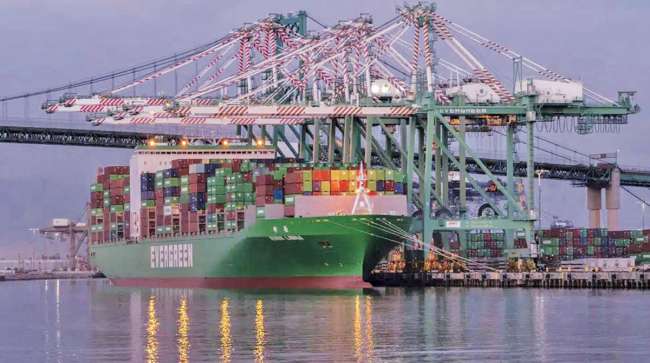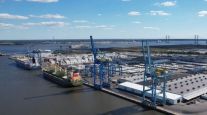Senior Reporter
Container Volumes Fall at Most US Ports

[Stay on top of transportation news: Get TTNews in your inbox.]
A combination of the Lunar New Year, ongoing labor negotiations and concern about a slowing global economy resulted in the Port of Los Angeles seeing a 43% year-over-year drop in container cargo in February.
The port processed 487,846 20-foot-equivalent containers, down from last year’s 857,764.
“February declines were exacerbated by an overall slowdown in global trade, extended Lunar New Year holiday closures in Asia, overstocked warehouses and a shift away from West Coast ports,” Port of Los Angeles Executive Director Gene Seroka said. “While we expect more cargo moving across our docks in March, volume will likely remain lighter than average in the first half of 2023.
Two months in, 1,213,860 TEUs have been handled compared with 1,723,360 in 2022, a nearly 32% decline.
The #PortofLA processed 487,846 Twenty-Foot Equivalent Units (TEUs) in February 2023, a 43% decrease from the previous February’s all-time record. Extended Lunar New Year closures, well-stocked retailers and economic concerns point to soft first quarter. https://t.co/LhsNHWDilv pic.twitter.com/pH6MJ8TgiE — Port of Los Angeles (@PortofLA) March 17, 2023
It was a similar story at the adjacent Port of Long Beach, which in February recorded a nearly 32% year-over-year decline
Long Beach processed 543,675 containers compared with 796,560 last year.

Port of Los Angeles Executive Director Gene Seroka (left) and Port of Long Beach Executive Director Mario Cordero
“Trade continues to normalize following the record-breaking cargo numbers we saw at the start of last year,” Port of Long Beach Executive Director Mario Cordero said. “We are investing in infrastructure projects that will keep us competitive as we collaborate with industry stakeholders to focus on trade volume.”
Meanwhile, negotiations resumed last month between the International Longshore and Warehouse Union and the Pacific Maritime Association, and ILWU insisted there will be no labor disruption.
Port operations at Seattle-Tacoma also slowed in February as the Northwest Seaport Alliance reported a 24% year-over-year decline to 225,747 containers compared with 298,046 in 2022.
The @PortofTacoma and @SeaportNW both work hard to invest & support our South Sound communities. Our ports foster tens of thousands of critical jobs in the region. I appreciate the update on the challenges and opportunities and ways the federal government can help. pic.twitter.com/47MdV53Pw1 — Congresswoman Marilyn Strickland (@RepStricklandWA) November 28, 2022
Like Los Angeles and Long Beach, Seattle-Tacoma officials say they are trying to take advantage of the lower volume to focus on infrastructure projects to prepare for when business begins to accelerate.
The Port of Oakland did not have its monthly numbers available at press time.
Port Houston notched a 15% year-over-year increase, processing 313,452 containers in February compared with 271,399.
The @SPGCI 2023 World Petrochemical Conference is coming to Houston next week! Hear from @Port_Houston's Executive Director Roger Guenther and Chief Commercial Officer John Moseley as they take the stage to discuss cargo fluidity, sustainability, carbon neutrality and more. #WPC pic.twitter.com/Cs4KVVOKcB — Port Houston (@Port_Houston) March 14, 2023
“We are the top resin port in the nation, and exports of container cargo with polymers and other petrochemical products remain strong at Port Houston, and we continue to make the investments in our facilities to handle future growth,” Port Houston Executive Director Roger Guenther said.
All of the port leaders said they are starting to see some of the more than $18 billion designated for the nation’s ports, under the Infrastructure Investment and Jobs Act, along with state, local and private money that is starting to be spent.
On the East Coast, the Port of Savannah, Ga., saw a 14% year-over-year decline in February, processing 394,793 containers compared with 460,413. This marked the first time in two years that Savannah saw volume dip below 400,000 TEUs.
@GaPorts continues Growing Big! According to new data, the Georgia Ports Authority now handles one out of every 8.8 loaded twenty-foot equivalent container units in the U.S., its highest national market share ever.https://t.co/jY1jvjyHYi#GrowingBig #GlobalGateway #GaPorts pic.twitter.com/BEpcXW03Mb — Georgia Ports (@GaPorts) March 14, 2023
Even with the year-over-year dip, port officials say that in fiscal 2023 through December, Savannah now handles one out of every 8.8 loaded 20-foot equivalent container units in the U.S., its highest national market share ever.
“As the nation’s top gateway for American farm and factory exports, the Port of Savannah serves as a hub for global commerce, linking every major ocean carrier calling the U.S. East Coast with superior connections to road and rail,” Georgia Ports Authority Executive Director Griff Lynch said.
In the past five years, Savannah has seen volume increase by nearly 46% to 5,892,131 TEUs in 2022 from 4,046,212 in 2017.
The Port of Charleston in South Carolina saw a 12.6% year-over-year decline in February, handling 201,418 containers compared with 230,420.
Charleston Harbor #keepingfreightmoving
Credit: @mpeacock28 pic.twitter.com/NZCdXWfiyn — South Carolina Ports (@SCPorts) March 2, 2023
With the recent dredging of the port now complete, and the harbor at 52 feet, the deepest on the East Coast, port officials say expansion is coming their way.
“Whether a farmer needs to export soybeans to international customers, or an automaker needs to import a part for its just-in-time manufacturing operation, companies know that SC Ports has a track record of delivering excellent service and customized solutions,” President and CEO Barbara Melvin said.
The port also is one step closer to having a near-dock rail, enhancing its intermodal capabilities.

Joel Morrow of Alpha Drivers Testing & Consulting traveled across America asking one simple question: What if a trucker designed a truck? Hear the program above and at RoadSigns.TTNews.com.
The Port of Virginia did not have volume numbers available at press time.
However, port officials did announce that beginning April 1, it will begin daily, direct rail service with Norfolk Southern between that facility and the railroad’s regional intermodal terminal in Rossville, Tenn., near Memphis.
Memphis is one of only four U.S. cities that is served by five Class I railroads, and freight can reach Canada, Mexico and 45 states in two days.
The Port Authority of New York and New Jersey usually runs one month behind the other ports in releasing its numbers. In January, the East Coast complex processed 645,430 containers, a 15.6% year-over-year decline from 765,050 TEUs.
Want more news? Listen to today's daily briefing below or go here for more info:




